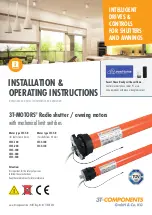
Marine Installation Manual
2021-08
3-11
3 Engine Installation
3.6 Assembly
X72DF
3.6
Assembly
Engines may be installed as complete units or assembled from subassemblies in
the vessel, which may be afloat, in dry dock, or on the slipway.
3.6.1
Assembly of subassemblies
When the engine seating has been approved, the bedplate is lowered onto blocks
placed between the chocking points. The thickness of the blocks depends on the
final alignment of the engine. Engine bedplates comprise fabricated sections with
tapped holes for the jacking screws for engine alignment, and drilled holes to
allow the passing of the holding-down bolts.
For checking the
dimensions optical
devices or lasers
may be used
•
Proceed with the preliminary alignment of the bedplate using wedges or
jacking screws.
•
Position the engine coupling flange to the intermediate shaft coupling
flange.
•
Ensure that the gap between both flanges is close to the calculated figures
and that both flanges are exactly parallel on the horizontal plane (max. de
-
viation 0.05mm).
•
In the vertical plane, set the engine coupling flange 0.4-0.6mm higher than
the calculated figures.
•
Place the bearing caps in position and install the turning gear.
•
Ensure that the crankshaft deflections are as recorded in the ‘Engine As
-
sembly Records’.
•
Check the bedplate level in longitudinal and diagonal directions with a taut-
wire measuring device provided by the engine builder.
•
Compare the readings with those recorded at works.
All final dimensions are to be witnessed by the representatives of the engine
builder and the classification society, and recorded on appropriate log sheets.
Crankshaft deflections at this stage are to correspond with the values recorded at
works.
•
Temporarily secure the bedplate against unexpected movement.
•
Continue engine assembly by mounting the columns, cylinder blocks, run
-
ning gear and scavenge air receiver.
•
Ensure that the bearing caps are loose before tensioning the tie rods.
•
Make periodic checks of the crankshaft deflections to observe and correct
any possible engine distortions.
•
Carry out careful adjustments of the wedges or the jacking screws to re-es
-
tablish the preliminary alignment setting.
Once the engine assembly is completed, the final alignment and chocking is car
-
ried out with the vessel afloat.
NOTE
The process of using jacking screws and wedges is defined in
and must be followed.
















































